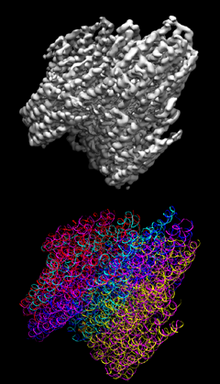
Back أوريغامي الحمض النووي Arabic DNA-Origami German Origami de ADN Spanish دیانای اوریگامی Persian Origami ADN French ADN origami Galician DNA אוריגמי HE Origami a DNA Italian DNAオリガミ Japanese DNA Origami Portuguese

DNA origami is the nanoscale folding of DNA to create arbitrary two- and three-dimensional shapes at the nanoscale. The specificity of the interactions between complementary base pairs make DNA a useful construction material, through design of its base sequences.[2] DNA is a well-understood material that is suitable for creating scaffolds that hold other molecules in place or to create structures all on its own.
DNA origami was the cover story of Nature on March 16, 2006.[3] Since then, DNA origami has progressed past an art form and has found a number of applications from drug delivery systems to uses as circuitry in plasmonic devices; however, most commercial applications remain in a concept or testing phase.[4]
- ^ Bai, Xiao-chen; Martin, Thomas G.; Scheres, Sjors H. W.; Dietz, Hendrik (2012-12-04). "Cryo-EM structure of a 3D DNA-origami object". Proceedings of the National Academy of Sciences. 109 (49): 20012–20017. doi:10.1073/pnas.1215713109. ISSN 0027-8424. PMC 3523823. PMID 23169645.
- ^ Zadegan, R.M.; Norton, M.L. (2012). "Structural DNA Nanotechnology: From Design to Applications". Int. J. Mol. Sci. 13 (6): 7149–7162. doi:10.3390/ijms13067149. PMC 3397516. PMID 22837684.
- ^ Rothemund, Paul W. K. (2006). "Folding DNA to create nanoscale shapes and patterns". Nature. 440 (7082): 297–302. Bibcode:2006Natur.440..297R. doi:10.1038/nature04586. PMID 16541064. S2CID 4316391.
- ^ Sanderson, Katharine (2010). "Bioengineering: What to make with DNA origami". Nature. 464 (7286): 158–159. doi:10.1038/464158a. PMID 20220817.
© MMXXIII Rich X Search. We shall prevail. All rights reserved. Rich X Search